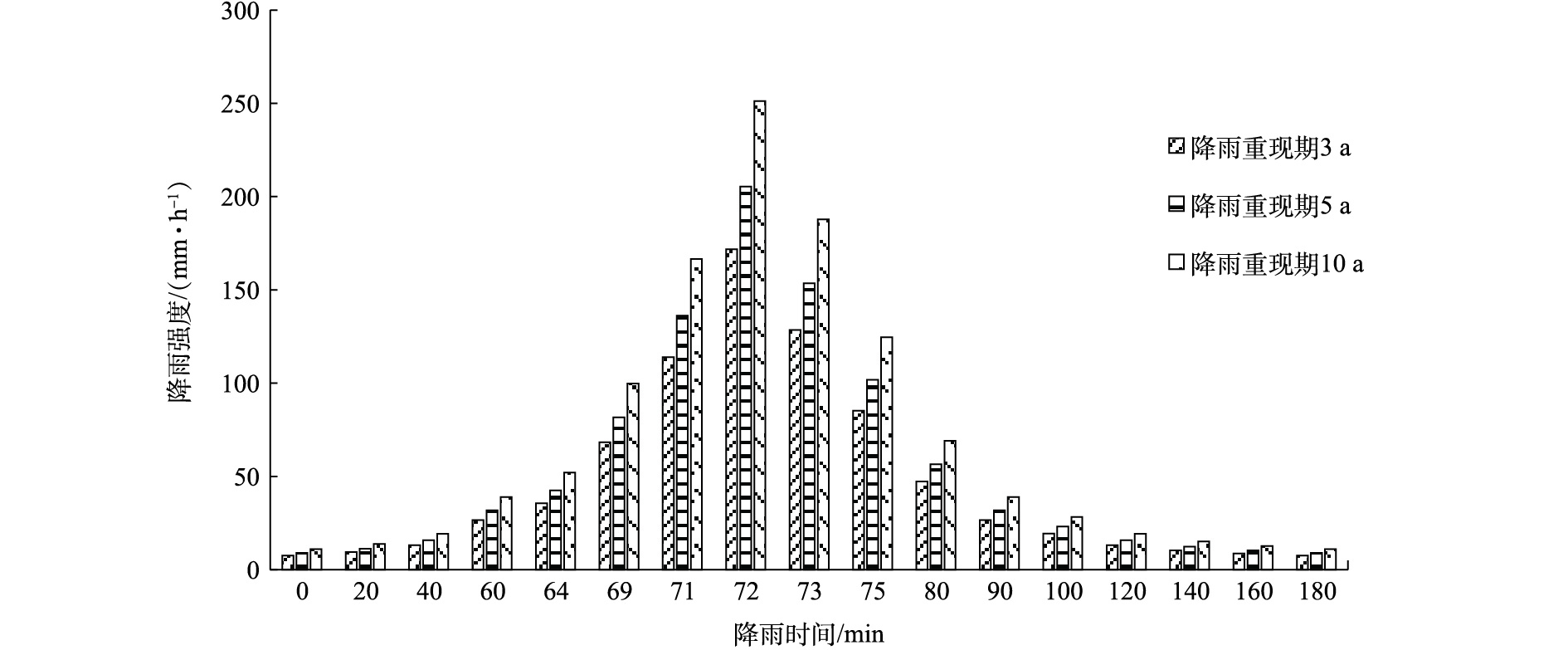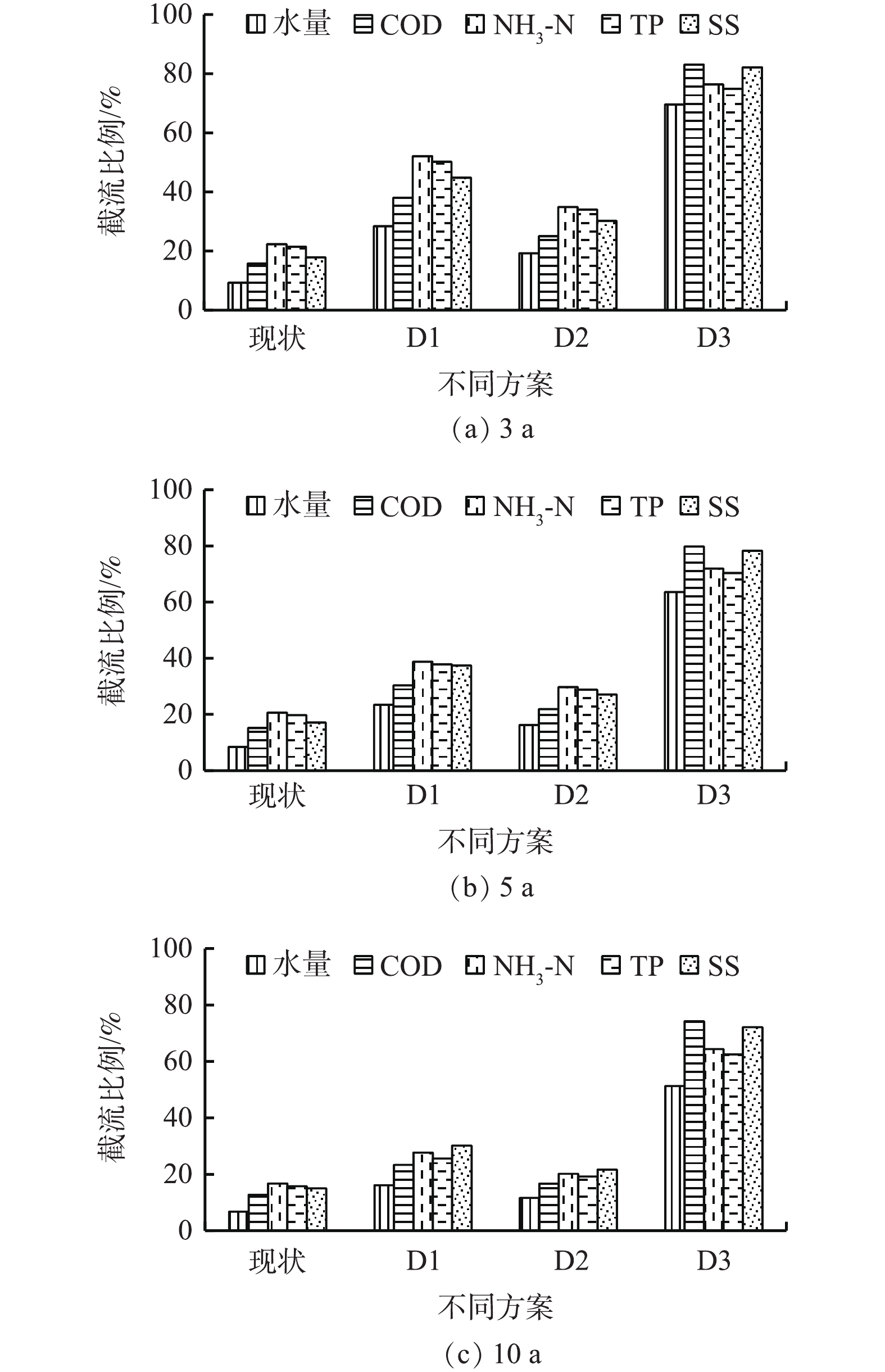-
近年来,随着城市生态环境的建设,我国城市点源污染控制效果良好,但合流制管道溢流(combined sewer overflows,CSOs)作为城市典型的非点源污染的危害日益凸显出来[1]。由于历史和经济等原因,合流制排水系统仍存在于国内外大多数老城区中,承载着城市生活污水和雨水收集、输送、排放等任务[2],但在降雨时,存在着溢流污染问题。溢流污水中含有各种病原微生物、氮磷等营养元素、各种病菌及有毒有害物质[3],会在降雨期间通过侵蚀或冲刷进行迁移,对城市水体造成污染[4]。合流制溢流污染已经成为城市水环境污染、生态系统失衡的重要原因[5],对城市生态环境产生了严重的威胁,因此,溢流污染的治理已十分紧迫[6-7]。
为治理污水溢流所造成的污染,须从源头上对管道进行改造。早在1964年,美国就开始对合流制管道溢流污染控制进行研究,经过几十年的发展,现已形成较为成熟的理论和技术[8]。合流制管道溢流污染控制核心包含2个方面:一方面是排水系统改造,如扩容管径、铺设新的输水管道、增加排水泵站等来提高截污效率,减少溢流量;另一方面是通过绿色措施,如雨水花园、生物滞留系统、绿色道路等从源头上降低排水管道负荷[9]。我国对合流制溢流污染研究起步较晚,一直没有予以足够的重视,以至于没有形成相关的法规与技术指导标准。现阶段,国内一些城市开始逐步重视了CSOs污染问题,并开展了相关研究及相应治理措施[10]。
为了响应国家《水污染防治行动计划》的明确要求,武汉市对巡司河制定了黑臭水体整治方案。本研究基于巡司河片区CSOs治理项目,以武汉市巡司河片区为研究对象,针对溢流污染问题,尝试借鉴工程实例并运用暴雨洪水管理模型(storm water management model,SWMM)软件建立该地区管网水力学模型。通过对工程措施的模拟,进行了污染物截流效率及年污染物溢流量的模拟评估,量化评价工程措施的运行效果,由此确定合理的治理方案,解决了合流制管网污水溢流所导致的城市内涝和城市内河黑臭问题,为国内合流制排水管网改造提供技术支持和海绵城市设计提供参考。
-
武汉市巡司河片区位于武汉市武昌区南部,地处亚热带大陆季风性(湿润)气候区,年降雨量1 150~1 450 mm,每年4—9月是主要雨期,降水量占全年70%左右。汇水区域包括武泰闸合流区子系统、晒湖合流区子系统、武船子系统和沿途合流子系统,总面积达到11.5 km2。该地区的总体地势较为平坦,典型下垫面包括道路路面、屋面、停车场、绿地等,根据道路面层,可以将路面分为水泥路面、沥青路面;根据屋顶材质,可以将屋面分为油毡屋面、水泥屋面、瓦屋面;根据植被种类,绿地以少部分草坪为主。
-
SWMM是由美国国家环境保护署(United States Environmental Protection Agency)于20世纪70年代研制的城市暴雨管理计算机模型[11]。该模型可模拟完整的城市降雨径流,包括地表径流和排水管网中水流、地表污染物的积聚与冲刷、合流污水溢流过程等,因此,对于合流制溢流污染特征分析和合流制排水管道的规划设计来说,是一个行之有效的工具。
汇水区域内地形数据主要采用1∶2 000地形图,根据巡司河地区实际道路的走向、街区的分布与地表径流的流向,将模拟区域人工划分为288个汇水子区域,面积从1.4 hm2到7.2 hm2不等,根据地形图,计算各汇水子区域的平均坡度为1%,汇水区域概化宽度为52.66 m。假设整个区域上的降雨是均匀的,每个子小区雨水就近汇入管网节点,再根据管网资料以及上述汇水区域的划分结果,将管道信息录入模型,排水管道的主干管均为钢筋混凝土管道。由此得到的管道概化结果,在288个汇水子区域里,排水管网概化为516个节点和515段管道,124个排口,5个电排站。
水力模型参数包括透水地面初始积洼深度、不透水地面初始积洼深度、透水地面曼宁系数等,此类参数需要依据实际情况并参照手册提供的参数[12]确定。其中入渗模型选择霍顿模型,最大入渗率、最小入渗率、入渗衰减系数分别为76 mm·h−1、3.3 mm·h−1、2 h−1[13];不透水地面初始积洼深度为1.5 mm;不透水地面粗糙系数为0.015;透水地面初始积洼深度为5 mm;透水地面粗糙系数为0.02;排水干管的材质为钢筋混凝土,通过查询SWMM用户手册,再参考国内的研究模拟成果,拟定管道曼宁系数为0.01;无洼地蓄水的不透水地表百分数为25%;汇流模型采用非线性水库模型;水力模型选择动力波。
-
本研究采用武汉市暴雨强度公式[14]进行暴雨强度计算,如式(1)所示。
式中:q为设计暴雨强度,L·(s·hm2)−1;P为重现期,a;t为降雨历时,min。
设计雨型采用芝加哥雨型[15],降雨重现期分别设为3、5、10 a,降雨历时为2 h,退水时间为2 h,模拟总历时为4 h。雨峰系数r取值如下:P=3 a时,r=0.4;P=5 a时,r=0.45;P=10 a时,r=0.5。设计降雨情况如图1所示。其中,降雨重现期在3 a时的总降雨量和峰值雨强分别为59.60 mm和171.82 mm·h−1,重现期为5 a时对应的总降雨量和峰值雨强分别为71.24 mm和205.37 mm·h−1,重现期为10 a时对应的总降雨量和峰值雨强的分别为87.14 mm和251.21 mm·h−1。
-
水样的监测指标包括化学需氧量(COD)、总磷(TP)、氨氮(NH3-N)、悬浮颗粒物(SS)。测试方法:SS采用重量法,TP采用钼酸铵分光光度法,COD采用重铬酸钾快速消解法,NH3-N采用纳氏试剂光度法。
事件平均浓度(CEMC)是整个降雨过程中所有瞬时污染物浓度对流量的加权平均值,其计算方法如式(2)所示。
式中:M为降雨事件中污染物总量,mg;V为降雨事件中总流量,L;Ct为t时刻污水中污染物的瞬时浓度,mg·L−1;Qt为t时刻的瞬时流量,L·h−1;t为发生溢流的时间,h;Cj为第j次取样污染物浓度,mg·L−1;Qj为第j次取样时的流量,L·h−1;m为径流事件次数。
排入受纳水体中的污染物总量分为2个部分,一部分是因为降雨而产生的溢流污染负荷;另一部分是日常污水直排产生的污染负荷。其中因降雨产生的溢流污染负荷是考察的重点,可按式(3)计算。
式中:Mj为第j个合流制溢流口因降雨产生的全年排污量,mg;Ci为第i场降雨溢流污水污染物浓度EMC值,mg·L−1;Ψ为综合径流系数;S为合流制管网服务面积,m2;hi为第i场降雨场次降雨量,mm;h0为形成径流所需降雨量,mm;Qd为日常污水日均排放量,L·h−1;ti为第i场降雨时间,h。
-
本项目采用遗传算法对水量模型参数进行了自动校核,对于水质模型参数,采用了人工校核。选取COD、SS、TP、NH3-N等4种水质指标作为参考来分析污染状况。根据SWMM使用手册及相关研究数据,初步确定模型水质参数,而后再根据现场实测数据对此参数进行调整,校准结果见表1。
利用研究区于 2017年3月6日和2017年4月4日监测的2场实际降雨监测数据,对模型进行模拟精度校核。由图2可见,模型模拟的流量过程与实测径流过程拟合较好,洪峰流量的模拟值和实测值相接近,表明校核后模拟精度较好,可满足工程需要。
-
排水系统在暴雨重现期分别为3、5、10 a,降雨历时均为2 h的降雨条件下,溢流情况的模拟结果如表2所示。由表2可知,在暴雨重现期为3 a时,截流水量仅为4.4×105 m3,溢流水量为427.95 m3,溢流水量远大于截流水量,截流比例仅为9%,各类污染物的溢流量也均超过截流量,截流比例均不超过25%,说明有大量的污水通过溢流管道流入巡司河中,对巡司河的水生态环境造成破坏。随着暴雨重现期的升高,截流量减小,溢流量增大,截流比例也显著减小。在实际情况下,如果溢流污水大于5×105 m3,城市自然水体的自净能力将无法处理溢流污水所造成的污染,很有可能导致水质下降,甚至变成黑臭水体[16]。
-
采用武汉市2014年和2015年的全年降雨数据对排水管道进行模拟,排水系统发生的溢流次数是全年溢流,结果如表3所示。由表3可以看出,全年溢流的污水接近2×107 m3,流入地表水中的COD约3 300 t、NH3-N约500 t、TP约60 t、SS约2 000 t,截流比例均小于70%,说明现有的合流制管网排水能力过小,一旦发生降雨,很有可能在雨水口附近产生路面积水,造成城市内涝,也会有大量的溢流污水流入地表水中,对环境造成破坏。由此可以推测,降雨发生后,管道内流量快速增加、排水管网超负荷运行是造成溢流量增加和城市内涝的主要原因。
因此,如何快速有效地处理这部分径流污水,是解决合流制溢流污染问题的关键。在本次模拟中,欲满足溢流控制规定,则须将年溢流量控制在5×105 m3以下,截流比例控制在85%以上,年溢流次数控制在10次以下。拟根据研究区域的土地利用情况,设计合理的溢流污染控制方案,增大该地区排水系统的调蓄能力及输水能力,减少溢流次数,从源头上降低溢流污水量,从根本上改变传统排水系统易渍涝、易污染的状况[17]。
-
根据研究区控制目标和总体规划,制定一套可行的方案,在实际工程中,通常采用多种工程措施协同作用的方案,发挥各工程措施的特点,实现控制效果最大化。通过分析比较几种典型的工程措施发现,扩增管径的综合效能相对较低,铺设新的输水管道,由于建造时须破坏大量的道路,会长时间影响交通情况,给人们正常工作带来很大影响,同时雨水花园造价和维护成本又过高。因此,根据目标需求以及研究区域场地条件,综合选择了3种工程措施:雨水调蓄池能够缓解管道负荷、减少溢流污水量及溢流次数、滞后洪峰时刻,是一种行之有效的“中端”治理措施[18-19];排水泵站能够有效降低降雨时排水系统所受到的冲击,控制溢流效果显著,且占地较少;箱涵具有较大的调蓄能力及输水能力,所以在安装箱涵之后,可以无须安装排水泵站来调控管网水量,然而在实际应用中,箱涵施工难度较大,而且需要较大的占地面积,对区域整体规划影响较大[20]。
措施布设情况见图3。D1及D2均采用雨水调蓄池和截流泵站组合措施,在晒湖箱涵的末端修建雨水调蓄池和截流泵站,武泰闸片区的溢流污水利用DN1500管道输送至截流泵站。首先利用截流泵站截流溢流污水,超出泵站截流能力的污水再被雨水调蓄池截流,没有被截流的污水最终溢流至巡司河。其中D1被截流的污水输送至下游处理设施,D2被截流的污水就地进行处理,D3利用雨水调蓄池和箱涵组合措施,截流来自武泰闸片区及晒湖片区的溢流污水,降雨初期,排渠箱涵闸门关闭,污水先流入调蓄池,调蓄池蓄满后,关闭进调蓄池闸门,污水进入下游截流箱涵,最后输送至下游处理设施,截流箱涵满负荷以后,污水溢流入巡司河,晴天利用排空泵站排空调蓄池。
-
1)设计重现期模拟。选取3、5、10 a降雨情景(降雨时间均为2 h)对3种方案模型进行模拟分析,探究各种方案在不同降雨强度下的控制效果,模拟结果见图4和表4。可以看出,在3~10 a的降雨重现期的条件下,D2的截流能力最差,径流总量分别减少了24%、20%、15%,D3的截流效果最好,径流总量分别减少了75%、68%、54%,但各方案的控制效果均好于现状排水系统,由模拟结果可以看出调蓄池对于降雨径流具有截流减量的作用。D2对SS截流比例分别为35%、30%、27%,D1对SS截流比例分别为47%、41%、33%,D3对SS截流比例分别为82%、78%、72%。由模拟结果可知,雨水调蓄池使得城市暴雨所带来的非点源污染程度有所降低,对污染物截流具有一定的强化效果,对污染物骤增骤减的现象有所缓解。但是随着重现期的增大,暴雨强度增加,雨水调蓄池对各污染物截流效果会随之减小,主要原因是管道输水能力有限,当降雨量随重现期增大而增大时,各措施的截流效果会逐渐减弱。D3对总径流量和污染物有较强的截流效果,这是由箱涵和雨水调蓄池共同作用的结果。
对比表1可以看出,D1和D2的溢流量与现状下的溢流量相差不大,但截流量有显著提高,比现状下的截流量提高了约200 m3,因此,导致溢流水量和污染物的截流比例有所提高。虽然截流量的提高能使雨水口附近道路处的路面积水减少,城市内涝问题有所缓解,但仍有大量的溢流污水流入地表水中,对环境造成破坏。D3的截流效果最好,不仅溢流量最小,截流效率也是3个方案里最大的,说明采用D3能使溢流进入巡司河的污水减少。因为箱涵具有较大的调蓄能力及输水能力,雨水调蓄池容积和水泵流量较小,而该地区主要用于截流来自箱涵的污水,根据管道拓扑关系分析,来自晒湖箱涵的污水占总水量的73%,因此,导致调蓄池和水泵的负荷增大,溢流污水增加,截流效率降低。D2在泵站流量与调蓄池容积的设置上与D1类似,但是由于就地一级强化处理的最大流量为2.5 m3·s−1,使得调蓄池与泵站的共同截流污水的能力受到限制,因此截流效率最低。
2)往年降雨控制效果分析。由上述模拟分析对比得知,D3对于溢流污染控制效果远优于其他方案。在连续降雨条件下,分别对3个方案进行模拟分析,探究3种方案在不同降雨强度下对污染物溢流量的截流能力,模拟结果见表5。可以看出,3种方案的水量总体的截流比例均大于90%,总体水质的截流比例均在95%以上,其中D3在2014年和2015年的溢流量分别为158.8 m3和142.39 m3,在3个方案中最少。对比表2的模拟结果,年溢流水量平均减少了1.75×107 m3、COD减少了3 295.5 t、NH3-N减少了505.8 t、TP减少了63.1 t、SS减少了1 981.1 t,溢流问题得到极大的缓解,控制污染成效显著。D2和D1的截流水量约为D3的5倍,说明在污水的调蓄和输送方面,能力稍有不足,较高的截流量会使排水管网长期处于高负荷状态,在溢流污染物方面,3种方案下所溢流的NH3-N和TP差距不大,但溢流的水量、COD和SS差距较大,D2和D1的溢流水量比D3多出约200 t,且只有D3的年溢流次数小于10次,这说明在年降雨量相同时,采用D3可以减少溢流进入巡司河的水量和污染物。
虽然溢流水量得到了有效的控制,但降雨后短时间内管道流量较大,依然存在积水和溢流隐患。这一问题反映出对合流制溢流污染的问题治理不能仅依赖于排水系统的改造,绿色设施(透水铺装、绿色屋顶、生物滞留池等)的相对缺乏,使得对径流雨水的截流、蓄水和削峰作用无法发挥[21],导致降雨径流快速汇入排水管道,使得管道内流量短时间内激增。过度依赖于排水系统改造,溢流控制效果会有所降低,应结合绿色设施,在控制溢流污染的同时,兼顾水质提升和美化环境,充分发挥各项措施的优势特点。
-
1) SWMM模型能有效模拟溢流污染的情况,在武汉地区适应性较好,且能对模拟效果进行量化,可作为CSO溢流污染控制和治理的有效工具,为更好的城市生态系统建设和合流制管网改造提供科学依据。
2)对武汉市巡司河区域分别构建现状模型、改造方案模型,并进行了模拟和对比分析,结果表明,通过D3在全年降雨情景模拟,可使巡司河区域年溢流次数降到10次以下,水量总体的截流比例均大于90%,总体水质的截流比例均在95%以上,年溢流水量平均减少了1.75×107 m3,COD减少了3 295.5 t,NH3-N减少了505.8 t,TP减少了63.1 t,SS减少了1 981.1 t,有效缓解了合流制管道溢流问题。
3)箱涵和调蓄池相结合的控制措施具有较大的调蓄能力及输水能力。在3、5和10 a的降雨重现期条件下,对径流总量截流比例分别为69%、63%、51%,对COD截流比例分别为83%、79%、74%,对NH3-N截流比例分别为76%、71%、64%,对TP截流比例分别为74%、70%、62%,对SS截流比例分别为82%、78%、72%。
基于SWMM模型的合流制管道溢流污染控制系统模拟
Simulation of combined sewer overflows pollution control system based on SWMM
-
摘要: 针对合流制管网污水溢流所导致的城市内涝和城市内河黑臭问题,以武汉市巡司河片区为例,利用暴雨洪水管理模型(storm water management model,SWMM)软件,构建该地区合流制排水系统的水力水质模型,模拟了不同降雨强度的暴雨模拟和全年降雨状况,分析了该地区溢流污染特征,据此提出了切实有效的合流制排水系统改造方案,并采用SWMM模型对不同改造方案的溢流水量和水质控制效果进行了模拟。结果表明,在箱涵与雨水调蓄池的共同作用下,对溢流污水量的截流比例在90%以上,年溢流次数小于10次,年溢流水量平均减少了1.75×107 m3,对污染物的截流比例均在95%以上,每年溢流进入地表水中的COD减少了3 295.5 t,NH3-N减少了505.8 t,TP减少了63.1 t,SS减少了1 981.1 t,溢流问题得到了极大的缓解,溢流污染能够得到较好的控制。随着暴雨重现期延长,截流效果会随之下降。箱涵和雨水调蓄池的组合措施对溢流污水具有明显的削减和调控作用,能够有效降低城市内涝隐患和缓解内河黑臭化问题,通过定量表征箱涵-雨水调蓄池组合在溢流污染方面的控制效果,为国内合流制排水管网改造提供技术支持和海绵城市设计提供参考。
-
关键词:
- 合流制污水溢流(CSOs) /
- 合流制排水管网 /
- SWMM /
- 雨水调蓄池
Abstract: Xunsi river area of Wuhan was taken as an example, aiming at the problems of urban water logging and black and odor problem in the urban inland river caused by sewage overflow in combined sewer network, the storm water management model (SWMM) software was used to establish the hydraulic and water quality model of the combined drainage networks. Both the rainstorm at different rainfall intensities and the annual rainfall were simulated, and the overflow pollution properties in the region were analyzed. The reasonable modification schemes for combined sewer drainage system in Xunsi river basin were proposed, and the overflow water volume and water quality control effects were simulated under different schemes by using of the SWMM. The results showed that under the joint action of culvert and storage tank, the interception ratio of overflow sewage volume was above 90%, the annual overflow times were less than 10, annual overflow water volume reduced by 17.517 million m3 on average, all the interception ratios of contaminant were above 95%. The COD, NH3-N, TP and SS entering the surface water through overflow dropped by 3 295.5, 505.8, 63.1 and 1 981.1 t every year, respectively. The overflow problem could be greatly alleviated, and the overflow pollution could be well controlled. With the increase of the recurrence period of rainstorm, the interception effect decreased. The combination of culvert and storage tank had significant reduction and control effects on overflow sewage, which could lower the risk of urban water logging and black and odor problem in the urban inland river. Through quantitative characterization of the control effect on overflow pollution by the combination of culvert and storage tank, this study provides a scientific basis for renovation of domestic combined drainage network and sponge city design in China. -

-
表 1 SWMM水质模型基本参数
Table 1. Basic parameters in water quality model of SWMM
水质
指标屋顶 路面 绿地 最大累积量/
(kg·(hm2)−1)半饱和累
积时间/d冲刷
系数冲刷
指数最大累积量/
(kg·(hm2)−1)半饱和累
积时间/d冲刷
系数冲刷
指数最大累积量/
(kg·(hm2)−1)半饱和累
积时间/d冲刷
系数冲刷
指数COD 80 10 0.006 1.8 170 10 0.007 1.8 40 10 0.004 1.2 SS 140 10 0.007 1.8 270 10 0.008 1.8 60 10 0.004 1.2 NH3-N 4 10 0.002 1.5 5 10 0.002 1.5 2 10 0.001 1.2 TP 0.4 10 0.002 1.6 0.2 10 0.002 1.6 0.6 10 0.001 1.2 表 2 不同重现期下的降雨模拟结果
Table 2. Results of rainfall simulation under different return periods
重现期/a 截流量 溢流量 截流比例 水量/(104 m3) 污染物/t 水量/(104 m3) 污染物/t 水量/% 污染物/% COD NH3-N TP SS COD NH3-N TP SS COD NH3-N TP SS 3 44 23.79 3.12 0.39 15.97 427.95 126.88 11.49 1.43 73.33 9 16 21 21 18 5 44.48 21.75 2.86 0.36 15.07 481.51 121.65 11.67 1.45 72.86 8 15 20 20 17 10 46.7 18.77 2.36 0.29 13.45 634.6 127.77 12.58 1.57 75.69 7 13 16 16 15 表 3 全年降雨模拟结果
Table 3. Simulation results of annual rainfall
年份 截流量 溢流量 水量/(104 m3) 污染物/t 水量/(104 m3) 污染物/t COD NH3-N TP SS COD NH3-N TP SS 2014 3 100.87 7 231.75 1 147.28 143.41 43 35.1 1 977.37 3 377.84 515.62 64.43 2 038.75 2015 3 071.72 7 298.67 1 160.9 145.11 4 376.61 1 827.29 3 248.13 500.29 62.52 1 953 表 4 不同重现期下各方案污染负荷的模拟结果
Table 4. Simulation results of pollutant loads under different rainfall return periods
方案 重现期/a 截流量 溢流量 截流比例 水量/(104 m3) 污染物/t 水量/(104 m3) 污染物/t 水量/% 污染物/% COD NH3-N TP SS COD NH3-N TP SS COD NH3-N TP SS 3 199.62 67.26 7.01 0.87 40.71 410.62 100.19 6.62 0.82 45.96 33 40 51 52 47 D1 5 204.96 56.06 5.49 0.68 34.62 545.4 110.44 7.82 0.97 50.52 27 34 41 41 41 10 214.67 44.32 3.97 0.49 28.45 919.01 127.7 10.42 1.3 58.6 19 26 28 28 33 3 141.83 54.86 5.69 0.71 32.81 459.57 125.07 9.61 1.16 61.81 24 30 37 38 35 D2 5 144.56 46.27 4.61 0.57 28.13 577.35 131.58 10.47 1.27 65.54 20 26 31 31 30 10 149.56 38.08 3.66 0.45 24.88 862.23 135.59 11.67 1.42 67.27 15 22 24 24 27 3 24.66 6.62 0.52 0.1 5.35 10.78 1.35 0.16 0.03 1.16 70 83 76 75 82 D3 5 25.26 5.97 0.49 0.09 5.02 14.47 1.51 0.19 0.04 1.39 64 80 72 70 78 10 26.7 5.84 0.47 0.09 4.89 25.34 2.02 0.26 0.05 1.88 51 74 64 63 72 表 5 不同年份下污染物溢流模拟结果
Table 5. Simulation results of pollutant overflow under different years
方案 年份 溢流
次数截流量 溢流量 截流比例 水量/
(104 m3)污染物/t 水量/
(104 m3)污染物/t 水量/% 污染物/% COD NH3-N TP SS COD NH3-N TP SS COD NH3-N TP SS D1 2014 31 5 250.56 8 007.0 1 256.6 157.1 4 813.8 324.25 68.9 5.5 0.7 36.2 94.2 99.2 99.6 99.6 99.3 2015 20 4 935.09 7 761.7 1 223.5 152.9 4 662.0 332.28 59.8 5.1 0.6 32.0 93.7 99.2 99.6 99.6 99.3 D2 2014 46 4 660.75 10 312.9 1 631.6 204.0 6 182.2 506.15 130.6 11.9 1.5 77.0 90.2 98.8 99.3 99.3 98.8 2015 32 4 527.42 10 302.8 1 635.4 204.4 6 177.7 498.80 114.7 10.7 1.3 66.1 90.1 98.9 99.4 99.4 98.9 D3 2014 9 1 109.13 737.9 110.0 22.4 792.4 158.80 20.3 2.5 0.5 16.8 90.5 97.3 97.8 97.8 97.9 2015 8 862.5 533.5 74.8 15.1 565.6 142.39 14.7 1.9 0.4 13.0 90.8 97.3 97.5 97.5 97.8 -
[1] TAEBI A, DROSTE R L. Pollution loads in urban runoff and sanitary wastewater[J]. Science of the Total Environment, 2004, 327(1/2/3): 175-184. [2] CHEBBO G, BACHOC A, LAPLACE D, et al. The transfer of solids in combined sewer networks[J]. Water Science & Technology, 2013, 31(7): 95-105. [3] GASPERI J, GROMAIRE M C, KAFI M, et al. Contributions of wastewater, runoff and sewer deposit erosion to wet weather pollutant loads in combined sewer systems[J]. Water Research, 2010, 44(20): 5875-5886. doi: 10.1016/j.watres.2010.07.008 [4] GROMAIRE-MERTZ M C, CHEBBO G, SAAD M. Origins and characteristics of urban wet weather pollution in combined sewer systems: The experimental urban catchment “Le Marais” in Paris[J]. Water Science and Technology, 1998, 37(1): 35-43. doi: 10.2166/wst.1998.0010 [5] 郭青海, 马克明, 杨柳. 城市非点源污染的主要来源及分类控制对策[J]. 环境科学, 2006, 27(11): 2170-2175. doi: 10.3321/j.issn:0250-3301.2006.11.006 [6] LYE D J. Rooftop runoff as a source of contamination: A review[J]. Science of the Total Environment, 2009, 407(21): 5429-5434. doi: 10.1016/j.scitotenv.2009.07.011 [7] 颜晓斐. 上海成都路合流污水调蓄池的污染减排效益及优化[J]. 中国给水排水, 2010, 26(8): 6-10. [8] 邢丽贞, 王恩革, 常青霞. 合流制污水溢流治理技术综述[J]. 山东建筑大学学报, 2011, 26(2): 166-169. doi: 10.3969/j.issn.1673-7644.2011.02.017 [9] 刘金平, 杜晓鹤, 薛燕, 等. 城市化与城市防洪理念的发展[J]. 中国水利, 2009(13): 15-18. doi: 10.3969/j.issn.1000-1123.2009.13.007 [10] 张辰. 合流制排水系统溢流调蓄技术研究及应用实例分析[J]. 城市道桥与防洪, 2006, 5(1): 1-4. doi: 10.3969/j.issn.1009-7716.2006.01.001 [11] 马俊花, 李婧菲, 徐一剑. 暴雨管理模型(SWMM)在城市排水系统雨季溢流问题中的应用[J]. 净水技术, 2012, 31(3): 10-15. doi: 10.3969/j.issn.1009-0177.2012.03.003 [12] LOWE S A. Sanitary sewer design using EPA storm watermanagement model(SWMM)[J]. Computer Applications Engineering Education, 2010, 18(2): 203-212. [13] 刘俊, 徐向阳. 城市雨洪模型在天津市区排水分析计算中的应用[J]. 海河水利, 2001(1): 9-11. doi: 10.3969/j.issn.1004-7328.2001.01.005 [14] 邵尧明. 中国城市新一代暴雨强度公式[M]. 北京: 中国建筑工业出版社, 2014. [15] 张大伟, 赵冬泉, 陈吉宁, 等. 芝加哥降雨过程线模型在排水系统模拟中的应用[J]. 给水排水, 2008, 34(s1): 354-357. [16] 赵磊, 杨逢乐, 王俊松, 等. 合流制排水系统降雨径流污染物的特性及来源[J]. 环境科学学报, 2008, 28(8): 1561-1570. doi: 10.3321/j.issn:0253-2468.2008.08.011 [17] 金建华, 徐振涛, 金溪, 等. 基于SWMM的天门北城区排水系统削峰及控污模拟分析[J]. 给水排水, 2018, 44(5): 121-126. doi: 10.3969/j.issn.1002-8471.2018.05.029 [18] 朱理铭, 李钏. 广州市雨水调蓄池规划技术研究[J]. 中国给水排水, 2010, 26(18): 46-49. [19] 陈华. 上海中心城区两类雨水调蓄池污染减排效应研究[J]. 中国给水排水, 2012, 28(15): 45-48. doi: 10.3969/j.issn.1000-4602.2012.15.012 [20] 曲平波. 潍坊市白浪河环境综合治理工程环境影响评价研究[D]. 青岛: 中国海洋大学, 2009. [21] 王红武, 毛云峰, 高原, 等. 低影响开发(LID)的工程措施及其效果[J]. 环境科学与技术, 2012, 35(10): 99-103. doi: 10.3969/j.issn.1003-6504.2012.10.021 -




 下载:
下载:




